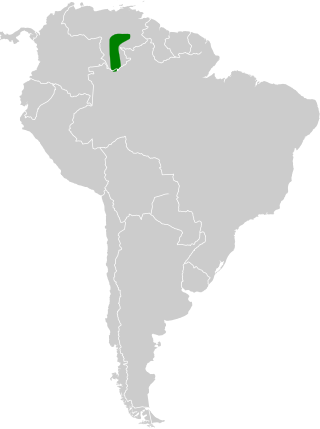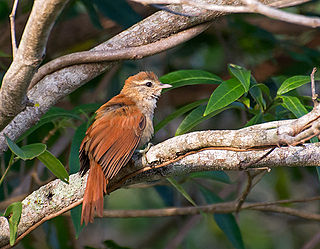
The buff-breasted sabrewing, or sometimes Duida sabrewing, is a species of hummingbird in the "emeralds", tribe Trochilini of subfamily Trochilinae. It is found in Brazil and Venezuela.

The rufous-breasted sabrewing is a species of hummingbird in the "emeralds", tribe Trochilini of subfamily Trochilinae. It is found in Brazil, Guyana, and Venezuela.

The spotted puffbird is a species of puffbird in the family Bucconidae, the puffbirds, nunlets, and nunbirds. It is found in Bolivia, Brazil, Colombia, Ecuador, French Guiana, Guyana, Peru, Suriname, and Venezuela.

The moustached puffbird is a species of near-passerine bird in the family Bucconidae, the puffbirds, nunlets, and nunbirds. It is one of seven species in the genus Malacoptila. It is found in Colombia, Ecuador, and Venezuela.

The chestnut-headed nunlet is a species of near-passerine bird in the family Bucconidae, the puffbirds, nunlets, and nunbirds. It is endemic to Brazil.

The brown nunlet is a species of near-passerine bird in the family Bucconidae, the puffbirds, nunlets, and nunbirds. It is found in Colombia, Ecuador, and Peru.

The grey-cheeked nunlet is a species of near-passerine bird in the family Bucconidae, the puffbirds, nunlets, and nunbirds. It is found in Colombia and Panama.

The rufous-capped nunlet is a species of near-passerine bird in the family Bucconidae, the puffbirds, nunlets, and nunbirds. It is found in Bolivia, Brazil, and Peru.

The fulvous-chinned nunlet is a species of near-passerine bird in the family Bucconidae, the puffbirds, nunlets, and nunbirds. It is found in Bolivia, Brazil, and Peru.

The rufous-vented ground cuckoo is a Vulnerable species of cuckoo in the tribe Neomorphini of subfamily Crotophaginae. It is found in Bolivia, Brazil, Colombia, Costa Rica, Ecuador, Nicaragua, Panama, and Peru.

The tepui foliage-gleaner, also known as the white-throated foliage-gleaner, is a species of bird in the Furnariinae subfamily of the ovenbird family Furnariidae. It is found in Brazil, Guyana and Venezuela.

The rusty-backed spinetail is a Neotropical species of bird in the Furnariinae subfamily of the ovenbird family Furnariidae. It is found in Bolivia, Brazil, Colombia, Paraguay, Peru, Venezuela, and possibly Guyana.

The spot-throated woodcreeper is a species of bird in subfamily Dendrocolaptinae of the ovenbird family Furnariidae. It is found in Brazil, Colombia, Ecuador, French Guiana, Guyana, Peru, Venezuela, and possibly Suriname.

The rufous-tailed foliage-gleaner is a species of bird in the Furnariinae subfamily of the ovenbird family Furnariidae. It is found in Bolivia, Brazil, Colombia, Ecuador, Guyana, Peru, Suriname, Venezuela, and possibly French Guiana.

The Roraiman barbtail is a species of bird in the Furnariinae subfamily of the ovenbird family Furnariidae. It is found in Brazil, Guyana, and Venezuela.

The tepui wren is a species of bird in the family Troglodytidae. It is found in Brazil, Guyana, and Venezuela, where it inhabits high tablelands called tepuis.

The straight-billed woodcreeper is a species of bird in the subfamily Dendrocolaptinae of the ovenbird family Furnariidae. It is found in Panama, on Trindad, and in every mainland South American country except Chile, Argentina, Paraguay and Uruguay.

The tepui toucanet or Whitely's toucanet is a near-passerine bird in the toucan family Ramphastidae. It is found in Brazil, Guyana, Suriname, and Venezuela.

The copper-tailed hummingbird is a species of hummingbird in the "emeralds", tribe Trochilini of subfamily Trochilinae. It is native to the tepuis of Venezuela and nearby areas of Brazil and Guyana ; it is a vagrant in French Guiana.

The rusty-winged antwren is a species of bird in subfamily Thamnophilinae of family Thamnophilidae, the "typical antbirds". It is found in Bolivia, Brazil, Colombia, Ecuador, Guyana, Panama, Peru, Suriname, and Venezuela.























